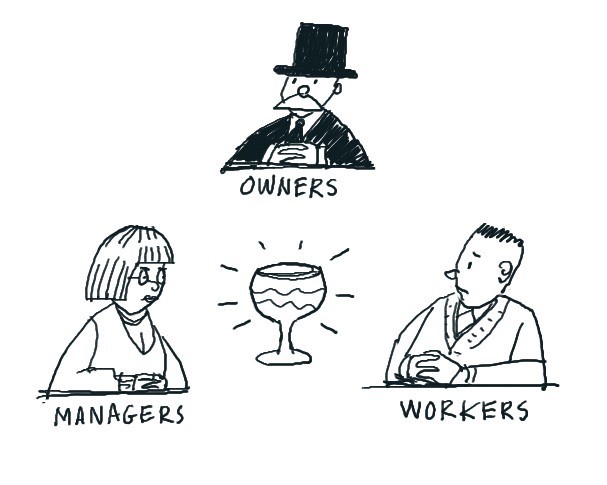A lot of problems in business could be solved if we could align the interests of employees and managers with owners. Is there a way to get everyone to act like owners? The answer is yes, but not without changing the structure of your company in ways that might make you a bit uncomfortable.
The idea of aligned incentives is kind of a holy grail. The goal is always the same: to align the interests of managers and employees with the owners of the business.
Why do so many incentive plans fail?
We pay commissions to salespeople because we want them to get energized about selling things. We use profit-sharing and stock options to get people excited about increasing the value of the business. We try to align executive pay with incentives like earnings growth, revenue growth or stock prices.
But too often these attempts fail to get people to think and act like owners. Why?
Short-term thinking. Since we have to reward people within a reasonable timeframe, many incentives tend to focus on short-term measures. Optimizing incentives for short-term results discourages long-term thinking that may be necessary to ensure the survival of the company in the long run. For example, in the rush to earn commissions, salespeople make deals that the company can’t make a profit on, or push customers to buy more than they need, or offer too much because they want to squeeze in a deal at the end of the quarter. Their efforts increase sales in the short run but destroy value in the long run. And for executives, there are always ways to drive up the stock price or other measures in ways that look good in the short term but destroy value in the long term.
Too vague. Stock-option and profit-sharing plans reward employees when the company does well, but the larger the company, the more difficult it becomes for people to feel that their efforts have an impact on the stock price. Frontline workers often have a hard time believing that anything they do can affect stock prices or profits one way or another. Their impact is just too small relative to the actions of the company as a whole.
The industrial era was built on the kind of carrot-and-stick management that rewards some behaviors and punishes others. This has been successful in a world of predictability, where work can be broken down into routine tasks that can be done according to a prescribed formula. But it won’t serve us in the 21st century. In the coming years we will need to get the absolute best our people can offer. We will need their heads and hearts as well as their hands.

In his book Drive: The Surprising Truth about What Motivates Us, Dan Pink cites research that indicates extrinsic rewards, such as sales commissions or other financial rewards, do work well under certain limited conditions: when a task simply requires people to follow a formula, such as Adam Smith’s famous pin factory. But for jobs that require complex or creative thinking, extrinsic rewards can be dangerous, because they tend to restrict people’s ability to notice things on the periphery and craft novel solutions.
Pink’s prescription is that in a world that increasingly requires people to think creatively, solve problems and remain flexible in uncertain environments, extrinsic incentives don’t work, and we should instead focus on the kinds of intrinsic motivation that drives artists, inventors and other creative professions: mastery, autonomy and purpose.
Certainly Pink’s point is an excellent one. Intrinsic motivation does indeed motivate people and drive creative success. But in business creative success is only part of the equation. In business we also need to make money. A quick look at the history of inventors and other creative people will confirm that, while creativity and invention may be necessary components of innovation, they are not sufficient if you want to achieve both innovation and business results.
The great innovators in business did not succeed on creativity alone; their success was a blend of creative thinking and business logic. There was no lack of creativity and invention in Xerox PARC, but Steve Jobs and Steve Wozniak were able to translate that creativity into a tangible product that people were willing to pay for. The great innovators in business – Henry Ford, Thomas Edison, Benjamin Franklin, John D. Rockefeller, Andrew Carnegie, Walt Disney, Sam Walton, Ted Turner and so on – blended creativity with business sense and a deep understanding of customers and market dynamics.
The challenge in aligning incentives is threefold: First, incentives must be real and tangible enough that people can see the impact they have on the business as a whole; second, they should balance long-term and short-term thinking; and third, they should balance rewards so they reward people for things that make the business as a whole healthier and more successful.
A good incentive system should reward people for thinking and acting like owners. So is it possible to get every worker to act as if they own the business?
It is possible. And the answer is actually quite simple. The way to get everyone to act as if they own the business is to give them a “business within the business.”
The podular organization.
To make this work, you first have to understand that the most common template for large-scale modern business design, the multidivisional corporation, is not the only way to do it. The multidivisional form, first realized by General Motors in 1920, has become the standard form today. While phenomenally effective in some ways, the multidivisional form also has significant weaknesses when it comes to innovation.
There are things that seem “obvious” about organization design that are in fact not so obvious at all. Some things that we take for granted as fundamental are in fact only optional.
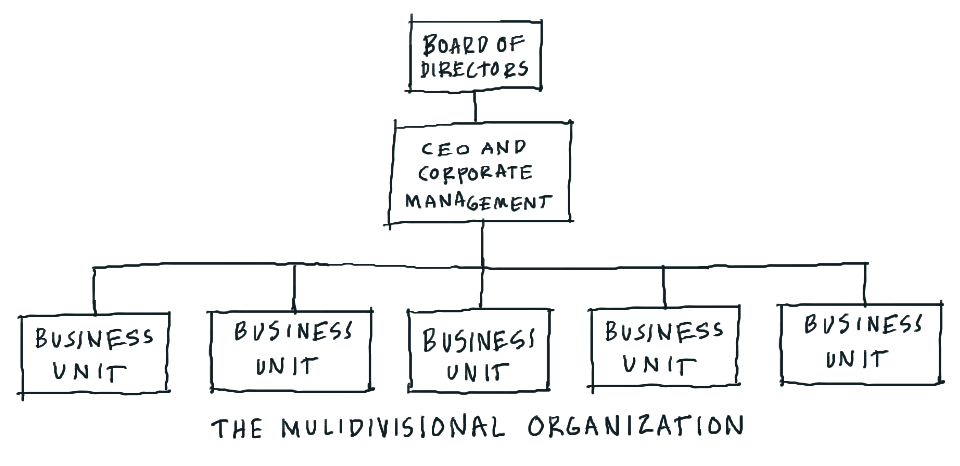
We tend to design organizations by splitting them into divisions. We divide the business, and the labor, in order to do work more efficiently. We put the software developers together so they can focus on software; we put the salespeople together so they can focus on selling and learn from each other, and so on. Sounds obvious, yes? And it’s very efficient. But as we move into a world where efficiency leads to commoditization, and where value will increasingly be driven by innovation, efficiency is no longer the overriding goal.
How can you divide the labor in your organization to optimize for innovation rather than efficiency? The answer is to supplement divisional thinking with another approach that I call podular thinking.
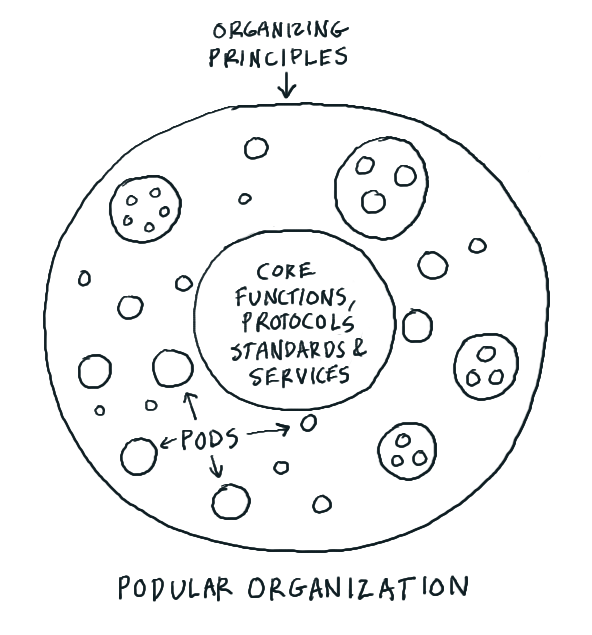
In a divisional organization, the kind we are all familiar with, you divide the labor into functions and specialties. As you continue to divide an organization in this way, you increase efficiency, but as a side effect you also disconnect the people from the overall purpose of the business. People in a functional group tend to identify with each other more than they identify with the purpose of the organization.
In a podular organization, you divide labor into “businesses within the business,” each of which can function as a complete service in its own right. Since each pod functions as a small business, its focus remains outside the pod, on its customers. Those customers might be inside or outside the organization as a whole, but each pod delivers a complete service. A podular approach allows a large company to act as if it were a flock or swarm of small companies; it gives the whole a level of flexibility and adaptiveness that would never be possible in a divisional organization. A podular organization is a fractal organization: every pod is an autonomous fractal unit that represents, and can function on behalf of, the business as a whole.
Does this sound strange? How is this possible?
Let’s look at four examples from four different industries: A food processing company, a retailer, a software company and a conglomerate.
Morning Star’s self-organizing marketplace.
Morning Star, a privately held company, was started in 1970 as a one-truck owner-operator hauling tomatoes. Today the company is the world’s largest tomato processor, with revenues of $700 million a year.
At Morning Star, workers manage themselves and report only to each other. The company provides a system and marketplace that allows workers to coordinate their activities. Every worker has suppliers and customers – and personal relationships – to consider as they go about their work.
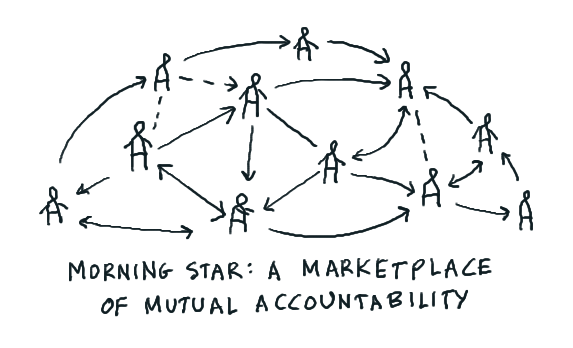
Every employee writes a personal mission statement that describes how they will contribute to the company’s goal, and is also responsible for the training, resources and cooperation they need to achieve it. Every employee also creates a yearly Colleague Letter of Understanding (CLOU), describing their promises and expectations for the coming year, negotiated in face-to-face meetings with peers. All the agreements, taken together, describe about 3,000 peer-to-peer relationships that describe the activities of the entire organization. Each Morning Star business unit also negotiates agreements with other units in a similar way.
If a worker needs something, they can issue a purchase order. If someone needs help or identifies a new role that’s needed to do the job better, they can start the hiring process. The bigger the dollar amount, of course, the more important it is to lobby your peers and get their buy-in for the purchase, because the unit will sink or swim together. Over time, workers tend to move from simpler to more complex roles, hiring people to fill the roles they need to support them. There’s no competition for management jobs because there are no management jobs. To get ahead, workers must find better and more valuable ways to serve their peers.
The discipline at Morning Star comes from a strong sense of mutual accountability. Problems are settled through mediation. If mediation can’t settle it, a panel of peers is convened. If that doesn’t work, a dispute will go to the president for a final decision. If the problem is serious or sustained enough, the worker may be fired. But while people can be fired, nobody has a boss hovering over them. What they do have is customers.
Every two weeks, the company publishes detailed reports of finances and other measures, that are transparent and available to everyone.
Business units are ranked by performance, and those at the bottom of the list can expect a tough conversation. In yearly planning meeting, business units present their plans to the entire company and workers invest using a virtual currency which then informs the budgets for the year. Workers elect compensation committees who evaluate performance and set pay levels based on performance.
Morning Star is a marketplace, where every worker is a business within the business. You can read more about Morning Star on their website or in this excellent HBR article by Gary Hamel, First, Let’s Fire All the Managers.
The Nordstrom way.
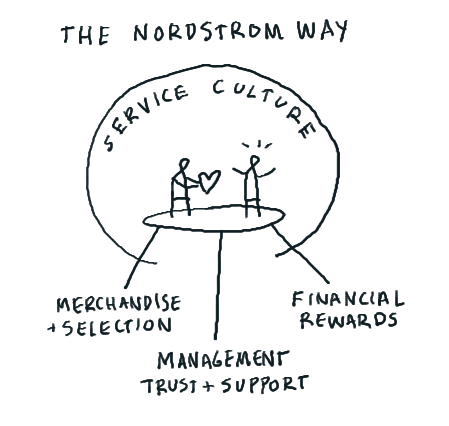
Nordstrom is a publicly traded high-end retailer, known for excellent service, with revenues of about $9 billion a year.
Nordstrom’s employee handbook is so short and simple it can fit on an index card. It states:
“Use your best judgment in all situations. There will be no other rules.”
Nordstrom salespeople are free to make their own decisions, although Nordstrom’s strong culture of putting the customer first provides a guiding light for all to steer by.
That customer-service culture is at the core of Nordstrom’s success. The entire system is organized in order to support that salesperson on the Nordstrom floor to help them deliver the best possible customer service. If Nordstrom stocks something, they will make every effort to stock it in every size available – they don’t want to disappoint a customer by not having something in their size.
Salespeople aren’t chained to a department like they are in other stores. If a salesperson wants to walk through the whole store to help her customer pick out clothes, shoes, cologne, and anything else, she can do that. A Nordstrom salesperson might stay in touch with customers by Twitter, email, or whatever else is convenient. The message to customers is: however you want to buy it, however you want to interact with us, we can do it that way.
Customers are encouraged to take things home and try them, and bring them back at any time. If you ask, “How long can I bring it back?” the answer you will hear is “forever.” And they mean it.
One Nordstrom customer said “What I love about Nordstrom is that if I want to browse by myself that’s fine, and if I want help people are there and happy to assist me.”
As you can imagine, customers love it.
Nordstrom has the faith and trust in its frontline people to push decision-making responsibilities down to the sales floor, the Nordstrom shopping experience is “as close to working with the owner of a small business as a customer can get,” said Harry Mullikin, chairman emeritus of Westin Hotels. Nordstrom salespeople “can make any decision that needs to be made. It’s like dealing with a one-person shop.”
— From The Nordstrom Way: The Insider Story of America’s #1 Customer Service Company by Robert Spector and Patrick D. McCarthy.
Nordstrom culture demands that the employee put the customer before company or profit in all decisions. Nordstrom provides a platform, the store, and each employee is treated as an entrepreneur who can set up a business on the platform. With commissions, Nordstrom salespeople can make six figures yearly on a base wage as low as $11 an hour. One worker stated:
The way I saw it, the Nordstroms were taking all of the risks and providing all of the ingredients-the nice stores, the ambiance, the high-quality merchandise-to make it work. All I had to do was arrive every morning prepared to give an honest day’s work, and to value and honor the customer.”
Nordstrom employees can offer the best service in the industry because every Nordstrom salesperson operates a business within the business, backed by the full support and resources of a Fortune 500 company.
Self-organizing teams at Rational Software.
Rational software was founded in 1981 to provide tools for software engineers. Rational was acquired by IBM for $2.1 billion in 2003. Since Rational has been acquired I will describe the company in the past tense, although it may operate similarly today as a group within IBM.
Rational’s goal was very transparent to everyone in the company: “Make customers successful.” Customers were served by small, autonomous pods known as field teams. Each field team operated as a fully functional, stand-alone unit, with technical and business experts working closely together. The same team who sold a product or project was also responsible for delivering it. Resources were distributed to teams based on their performance.
Rational’s team-based approach permeated the culture at all levels. “If you weren’t team oriented, you wouldn’t survive” says Jerry Rudisin, Rational’s VP of Marketing from 1991 to 1999. Rational put team orientation first even when it hurt the bottom line in the short term. “When I was a district manager, I fired the top sales rep more than once” says Kevin Kernan, who worked at Rational in a variety of roles for 17 years. “We had zero tolerance for people who didn’t exhibit team behavior – that was just poisonous to our culture.”
The cross-functional teams at Rational were a great way to build entrepreneurial skills within the company, because every team member understood every aspect of the business. Team members worked closely together and learned from each other constantly. As the company grew, many technologists grew into new careers in sales, fielding their own teams in new territories. Many went on to start companies of their own.
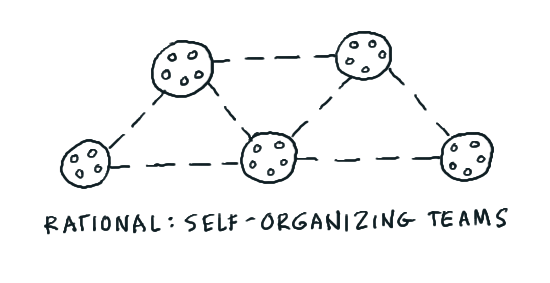
Rational management focused on managing the teams as if they were a portfolio of companies. Teams were evaluated on five things: First and foremost, customer success: Did the team help customers succeed in achieving their goals? Revenue: Did the team make or beat its revenue targets? Team development: Was the team optimizing for the career growth of each team member as well as the team? Territory growth: Was the team growing in reach as well as revenue? Business basics: Did the team play well with other teams? Did they spend money as if it was their own?
“You could have a team that did poorly in their overall ranking even though they made their revenue target, because their customers weren’t successful in achieving their goals” says Kernan. One year a new sales rep in a 7-person team was fired because he didn’t treat his team well and had filed some paperwork that was misleading, even though the deals he made with customers were all solid and his sales accounted for 25% of the company’s revenue.
Top-down intervention in team dynamics was rarely necessary. When a team member wasn’t performing, the greatest pressure for improvement came from the team itself. “When I was a district manager I had 25 direct reports, but I rarely intervened. The teams basically managed themselves” says Kernan.
Teams made their own hiring decisions, and hired outside consultants or traded resources with other teams when necessary. “You had to be careful when you brought on a new member,” says Ray LaDriere, who worked in one of the Rational sales pods. “If you hired someone and they didn’t pull their weight, the deal was that we had to carry them for a full year.” Since one poor performer could hurt the performance of the whole team, people were very careful in their hiring decisions.
“It was an amazing experience for 17 years, and I would be surprised if you found anyone who worked at Rational for any significant period of time that didn’t feel the same way” says Kernan. “Our goal was to change the world by changing the way people design, build, and deploy software. And we did it.
Democratic management at Semco.
Semco is a Brazilian conglomerate that specializes in complex technologies and services like manufacturing liquids, powders and pastes for a variety of industries; refrigeration; logistics, and information processing systems; real estate, inventory and asset management; and biofuels. Semco’s revenues are around $200 million a year.
Semco is a self-managed company. There is no HR department. Workers at Semco choose what they do as well as where and when they do it. They even choose their own salaries. Subordinates review their supervisors and elect corporate leadership. They also initiate moves into new businesses and out of old ones. The company is run like a democracy.
Says CEO Ricardo Semler: “I’m often asked: How do you control a system like this? Answer: I don’t. I let the system work for itself.”
Semco is organized around the belief that employees who can participate in a company’s important decisions will be more motivated and make better choices than people receiving orders from bosses. Workers in each business unit are represented by an elected committee that meets with top managers regularly to discuss any and all workplace issues, and on important decisions, such as plant relocations, every employee gets a vote.
Workers at Semco choose their own hours. CEO Semler recalls that when he first proposed the idea, managers were convinced this wouldn’t work, especially when it came to factory work. But Semler was confident. “Don’t you think they know how to manage their own work?” he asked. Turns out they did, and they do.
Semler says simply, “if you want people to act like adults you need to treat them like adults.”
Things do take longer than they do in a traditional, hierarchically-managed company. Semler elaborates in his book Maverick: The Success Story Behind the World’s Most Unusual Workplace:
Dissent and democracy go hand in hand. It’s also good management technique. What traditional executives don’t consider is that decisions arising from debate are implemented much more quickly because explanations, alternatives, objections, and uncertainties have already been aired.”
One of the principles underlying Semco’s success is the idea that every business should be small enough that each worker can comprehend it as a whole system. If a business grows to more than 150 people, Semco will split it into two.
Another principle is transparency and trust.
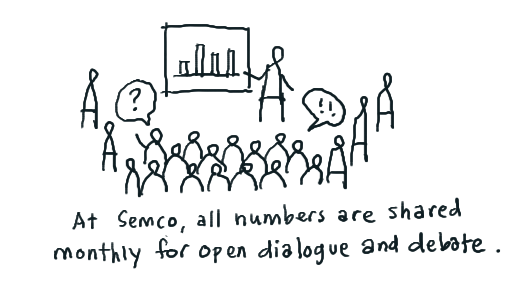
“The only source of power in an organization is information, and withholding, filtering, or retaining information only serves those who want to accumulate power through hoarding,” says Semler.
Once a month Semco holds open meetings for the employees of each unit, where all the numbers in the business are presented for open examination and debate. The company also offers courses to help employees better understand financial reports such as balance sheets, Profit-and-loss reports, and cash flow statements.
What about profits?
Profit is highly important to us at Semco, and we’re as avid about it as a general is about his supplies. If provisions run out, his soldiers will die. If a company ceases to make money, it too will die. But armies are not created to feed soldiers, just as companies don’t generate income just so they can hire more employees. Food fuels the soldiers and keeps them going. Yet to serve as more than mere gun fodder, they must have a higher purpose, a reason for going through boot camp and charging the enemy in battle… This is where profit and purpose meet and, unfortunately for most organizations, it’s a head-on Humvee wreck.”
— Ricardo Semler, The Seven-Day Weekend: Changing the Way Work Works.
Nearly a quarter of Semco’s profits go to employees, but the company doesn’t decide how to distribute it. Each quarter, the profit contribution of each unit is calculated, and 23% of profits go to that unit’s employees, who can distribute it however they wish. So far, they have always decided to distribute that money evenly to everyone.
Employees who are particularly confident can choose to put up to 25% of their pay “at risk.” If the company does well, they get a bonus raising their compensation to 150% of normal; if the company does poorly, they are stuck with 75% of their pay.
Does it work? Semco’s growth from $4 million in 1980 to more than $200 million today seems to point in that direction.
Can your company go podular?
Although each company has done it differently, Morning Star, Nordstrom, Rational and Semco have all found success by organizing along podular lines. This kind of design won’t make sense for every situation, or for every division. But no company can afford to ignore its innovation efforts. To ensure its long-term viability, every company needs to find a balance between their efficiency and innovation efforts.
The podular organization may be unusual, but it’s not a theory. It’s a fact. It can work in retail, it can work in manufacturing, it can work in technology, and it can work for a conglomerate. It can work for private as well as publicly-traded companies. It can work for a Fortune 500 company. Can it work for you? You can only find out if you’re willing to give it a chance.
You might start by reorganizing a single unit, like an innovation unit, a single store or location, or an R&D group. Look inside any R&D department or fast-growing web services company and you are likely to see a form of organization that’s more podular than hierarchical.
Podular organizations need to do a few things in radically different ways: First, they require information to be transparent and readable by everyone; second, they require principles, platforms and culture to guide individual decisions and give cohesion to the company as a whole; third, they require people who are not territorial, who are capable of open discussion and who will hold themselves and others accountable; and fourth; they require owners and managers who are capable of trusting people and teams to make good decisions and manage their “business within the business.”
When you give people a business within your business, you are aligning their incentives with owners and management. Everyone is a business owner, and everyone is a manager. Rewards are real and tangible, short-term and long-term benefits are in balance, and workers are rewarded when they are good stewards of the business.
If you want to unleash innovation, get closer to customers, and manage complexity, pods are worth a look.
Excerpted from Dave Gray’s book, The Connected Company.
Learn faster and move faster than your competitors by applying the Connected Company principles to your work.We offer workshops for teams on the Connect Company principles. Learn more about how your company can use the same principles to adapt—and thrive—in today’s ever-changing global marketplace. |
